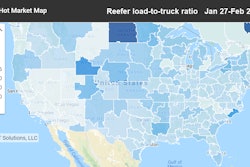Only in February can you say that a dip in truckload volumes and rates is a good sign. The week-over-week declines for spot van, refrigerated and flatbed freight during the week ending Feb. 16 were modest compared to the steady slide that began in early January, said DAT Solutions, which operates the DAT network of load boards.
The national average reefer load-to-truck ratio was unchanged at 3.7 loads per truck last week, the van ratio likewise neutral at 1.8, though, indications that demand is firming up and rates may be bottoming out.
National average spot rates, February (through the 16th)
**Van: $1.80 per mile, down 7 cents from the January average
**Reefer: $2.11 per mile, down 13 cents
**Flatbed: $2.14 per mile, down 3 cents
Trend to watch: Commercial construction
Flatbed freight has been something of a lone bright spot through the difficult winter period, when it comes to demand. The national average flatbed load-to-truck ratio has increased over the past four weeks from 14.9 to 19.8.
Some of the highest ratios are in the Southeast, where new housing, office and warehouse projects have pushed commercial construction activity to higher levels. Dallas, Atlanta, Houston, and Austin were among metro areas posting the largest gains in the value of commercial and multifamily construction starts last year.
Market to watch, part 1: Florida reefers
It’s early for a big Florida produce push, but rates are moving higher on several key lanes:
**Miami to Atlanta: $1.76 per mile, up 27 cents
**Miami to Elizabeth, New Jersey: $1.71, up 12 cents
**Lakeland to Charlotte: $1.58, up 10 cents
Imports and exports are also giving the reefer market a lift, with elevated load-to-truck ratios in the port cities of Savannah, Ga., Charleston, S.C., and Wilmington, N.C.
Market to watch, part 2: West Coast ports
Right now, DAT data shows no real impact of the coronavirus on domestic trucking — travel restrictions have affected sea and air freight far more. February is a slow month for imports from China anyway, because so many seaports reduce their activity during the Lunar New Year holidays.
The longer-term effect on U.S. imports and spot truckload freight, especially at West Coast ports, depends on whether governments take more aggressive steps to curtail commercial traffic from Wuhan and elsewhere.
Ports are bracing for the impact on volumes as the number of canceled sailings has reached unprecedented levels, making it more likely that the seasonal lull at U.S. ports will extend into March. At that point we can start to connect unusual truckload freight volumes on certain lanes with efforts to contain the outbreak.









